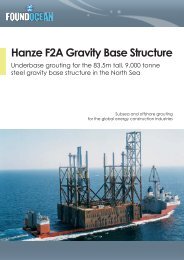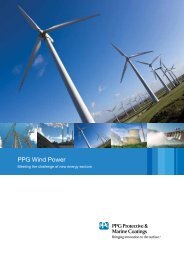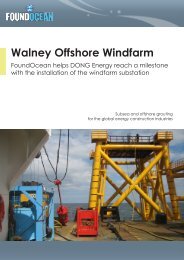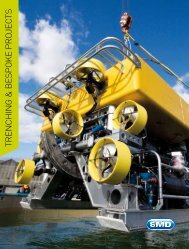WORKING AT HEIGHTS - Wind Energy Network
WORKING AT HEIGHTS - Wind Energy Network
WORKING AT HEIGHTS - Wind Energy Network
Create successful ePaper yourself
Turn your PDF publications into a flip-book with our unique Google optimized e-Paper software.
SPONSORS OF legal eaglesUK on the cusp of anew energy eraWith the British Governmentcommitted to generating 13GWwith onshore wind turbines by2020, changes are afoot.Ambitious targetsThese wind power targets are certainlyambitious but foundations are being laid nowto make the transition into renewable energysmoother. Recent statistics published by theDepartment of <strong>Energy</strong> and Climate changeindicate that the amount of clean electricitygenerated for UK homes, businesses andfactories has increased significantly. Figuresreveal that wind energy output improved by athird in 2012, when compared to 2011.Embracing renewable energyThese figures indicate that the country isembracing renewable energy and is readyfor change. Despite the increase in windpower output, planning hurdles associatedwith applications are blocking potential forfurther wind turbine utilisation.The country’s bold targets could be at riskof failure. Fresh thinking must be appliedbefore the momentum slows and Britain’srenewable energy hopes become a missedopportunity.The National Planning PolicyFramework (NPPF)There are two main pitfalls to successfulrenewable energy deployment in the UK:planning and financing.The National Planning Policy Framework(NPPF) has been introduced to ensureplanning efficiency. Its main function isto oversee and support local planningauthorities’ plan-making and decision-takingfunctions.Time is moneyWhile the framework has aided planningofficials, eager applicants are not feelingthe benefits. Currently medium sizedturbines can take up to 24 months topass the planning stage. Despite thisimprovement on previous timescales, it stillfalls short of what is needed. As the oldadage goes, time is money.Capitalising on potentialThere is a real dynamism in the SME sectorto capitalise on the potential of renewableenergy. SMEs could be losing out on vitalincome as projects can languish in theplanning system for years until approvalis awarded. These decisions often cometoo late for small scale businesses keen tobenefit from the revenue generated by windturbines in farms or factories. Alternativeforms of energy are being readily usedto power businesses, but more supportis needed to assist and develop SMEambitions.Funding the futureTackling planning backlogs requirescollaboration. For example, last year inScotland the Convention of Scottish LocalAuthorities and Heads of Planning Scotlandcame together to create a fund to deal withwind turbine application bottlenecks. The£300,000 assigned was welcomed and kickstartednumerous projects across Scotland.Strategies like these are exemplary andsimilar incentives can be introducedthroughout the whole country. Onshoreturbine applications are at an all time high,but these developments do not come tofruition as quickly as hoped. If funding wasreadily available to form specialised teamsof wind turbines planners, the backlog ofapplications would be significantly reduced.‘Tax per project’ schemeA ‘tax per project’ scheme could supportthe highly skilled and specified flying squadof planning professionals, who are focusedsolely on speeding up the renewablesplanning application process. This hascome to fruition on a small scale, but thereneeds to be widespread commitment andsupport from local authorities, right throughto government level.UK - Challenge to wind farmdevelopment in High CourtquashedRES UK & Ireland recently succeededin defending a statutory challenge toplanning permission that had beengranted for its proposed wind farmdevelopment, known as “Jack’sLane”, in North-West Norfolk.The challengeThe challenge, which also involved anearby wind farm development proposedby E.ON, was brought by two actiongroups who resisted both planningapplications at the Inquiry stage. Thegroups sought to quash the decisionto grant planning permission for bothdevelopments on cultural heritagegrounds.Expedited hearingAn expedited hearing of the claim wassecured in order to minimise the delayand uncertainty on the project. Despitethe Secretary of State withdrawing fromthe proceedings, and agreeing to thepermission being quashed a week beforetrial, both RES and E.ON continuedto defend the claim at the hearing inDecember.High Court decisionThe decision of the High Court to dismissthe claim and uphold the planningpermission was welcomed by RES asbeing the right result obtained in difficultcircumstances, and vindicated thedecision to continue with its defencedespite the Secretary of State’swithdrawal.RES Project Manager Helen Wilson said:“We are very pleased with the decision,which supports the Planning Inspector’sview at the inquiry last year. We areabsolutely confident that the wind farmwill be a positive asset to people livingaround it.”82www.windenergynetwork.co.uk
















